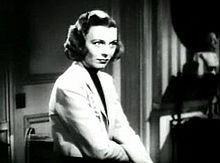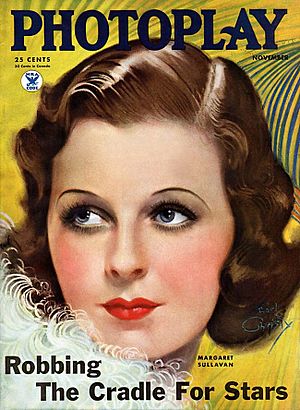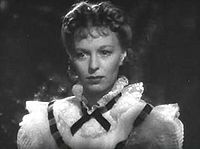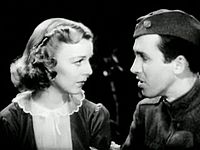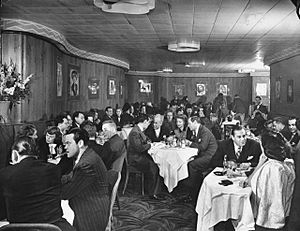Margaret Sullavan facts for kids
Quick facts for kids
Margaret Sullavan
|
|
|---|---|
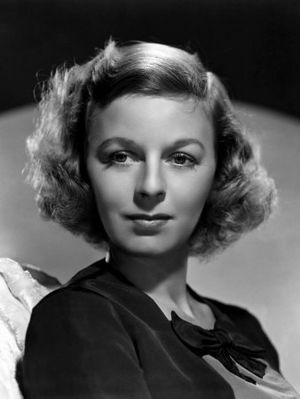
Sullavan in 1940
|
|
| Born |
Margaret Brooke Sullavan
May 16, 1909 Norfolk, Virginia, U.S.
|
| Died | January 1, 1960 (aged 50) New Haven, Connecticut, U.S.
|
| Resting place | Saint Mary's Whitechapel Episcopal Churchyard |
| Occupation | Actress |
| Years active | 1929–1960 |
| Spouse(s) |
Leland Hayward
(m. 1936; div. 1948)Kenneth Wagg
(m. 1950) |
| Children | 3, including Brooke Hayward |
Margaret Brooke Sullavan (May 16, 1909 – January 1, 1960) was an American stage and film actress.
Sullavan began her career onstage in 1929 with the University Players. In 1933, she caught the attention of film director John M. Stahl and had her debut on the screen that same year in Only Yesterday. She continued to be successful on stage and film, best known for The Shop Around the Corner.
Sullavan preferred working on the stage and only made 16 films, four of which were opposite close friend James Stewart in a popular partnership that included The Mortal Storm and The Shop Around the Corner. Stewart and Sullavan were also close friends of Henry Fonda, to whom Sullavan was married from 1931 to 1933. She was nominated for an Academy Award for Best Actress for her performance in Three Comrades (1938). She retired from the screen in the early 1940s to devote herself to her children and stage work. She returned to the screen in 1950 to make her last film, No Sad Songs for Me, in which she played a woman dying of cancer. For the rest of her career, she appeared only on the stage. Popular stage portrayals included Terry Randall in Stage Door, Sally Middleton in The Voice of the Turtle and Sabrina Fairchild in Sabrina Fair.
Sullavan, who experienced deafness and depression during the 1950s, died on January 1, 1960, at the age of 50.
Contents
Early life
Sullavan was born in 1909 Norfolk, Virginia, the daughter of a wealthy stockbroker, Cornelius Sullavan, and his wife, Garland Councill Sullavan. She had a younger brother, Cornelius, and a half-sister, Louise Gregory. The first years of her childhood were spent isolated from other children. She suffered from a painful muscular weakness in the legs that prevented her from walking, so that she was unable to socialize with other children until the age of six. After her recovery she emerged as an adventurous and tomboyish child who preferred playing with the children from the poorer neighborhood, much to the disapproval of her class-conscious parents. Her first dance performances were at Sunday School at St. Andrew's Episcopal Church.
She attended boarding school at Chatham Episcopal Institute (now Chatham Hall), where she was president of the student body and delivered the salutatory oration in 1927. She moved to Boston and lived with her half-sister, Weedie, while she studied dance at the Boston Denishawn studio and (against her parents' wishes) drama at the Copley Theatre. When her parents cut her allowance to a minimum, Sullavan defiantly paid her way by working as a clerk in the Harvard Cooperative Bookstore (The Coop), located in Harvard Square, Cambridge.
Career
Early years
Sullavan succeeded in getting a chorus part in the Harvard Dramatic Society 1929 spring production Close Up, a musical written by Harvard senior Bernard Hanighen, who was later a composer for Broadway and Hollywood.
The President of the Harvard Dramatic Society, Charles Leatherbee, along with the President of Princeton's Theatre Intime, Bretaigne Windust, who together had established the University Players on Cape Cod the summer before, persuaded Sullavan to join them for their second summer season. Another member of the University Players was Henry Fonda, who had the comic lead in Close Up.
In the summer of 1929, Sullavan appeared opposite Fonda in The Devil in the Cheese, her debut on the professional stage. She returned for most of the University Players' 1930 season. In 1931, she squeezed in one production with the University Players between the closing of the Broadway production of A Modern Virgin in July and its tour in September. She rejoined the University Players for most of their 18-week 1930–31 winter season in Baltimore.
Sullavan's parents did not approve of her choice of career. She played the lead in Strictly Dishonorable (1930) by Preston Sturges, which her parents attended. Confronted with her evident talent, their objections ceased. "To my deep relief," Sullavan later recalled, "I thought I'd have to put up with their yappings on the subject forever."
A Shubert scout saw her in that play as well and eventually she met Lee Shubert himself. At the time, Sullavan was suffering from a bad case of laryngitis and her voice was huskier than usual. Shubert loved it. In subsequent years Sullavan would joke that she cultivated that "laryngitis" into a permanent hoarseness by standing in every available draft.
Sullavan made her debut on Broadway in A Modern Virgin (a comedy by Elmer Harris) on May 20, 1931, and began touring on August 3.
At one point in 1932, she starred in four Broadway flops in a row (If Love Were All, Happy Landing, Chrysalis (with Humphrey Bogart), and Bad Manners), but the critics praised Sullavan for her performances in all of them. In March 1933, Sullavan replaced another actor in Dinner at Eight in New York. Movie director John M. Stahl happened to be watching the play and was intrigued by Sullavan. He decided she would be perfect for a picture he was planning, Only Yesterday.
At that time Sullavan had already turned down offers for five-year contracts from Paramount and Columbia. Sullavan was offered a three-year, two-pictures-per-year contract at $1,200 per week. She accepted it and had a clause put in her contract that allowed her to return to the stage on occasion. Later in her career, Sullavan signed only short-term contracts because she did not want to be "owned" by any studio.
Hollywood
Sullavan arrived in Hollywood on May 16, 1933, her 24th birthday. Her film debut came that same year in Only Yesterday. When she saw herself in the film's early rushes, she was so appalled that she tried to purchase her contract for $2,500, but Universal refused.
Sullavan's next role came in Little Man, What Now? (1934), a film about a couple struggling to survive in impoverished post–World War I Germany. Universal was reluctant to produce a film about unemployment, starvation and homelessness, but Little Man was an important project to Sullavan. She would list the film appearance among the few Hollywood roles that afforded her a great measure of satisfaction.
In The Good Fairy (1935), Sullavan was able to illustrate her versatility. During the production, she married its director, William Wyler.
King Vidor's So Red the Rose (1935) dealt with people in the postbellum South and preceded the publication of Margaret Mitchell's bestselling novel Gone With the Wind by one year and the blockbuster film adaptation by four years. Sullavan played a childish Southern belle who matures into a responsible woman.
In Next Time We Love (1936), Sullavan played opposite the then-unknown James Stewart. She had been campaigning for Stewart to be her leading man, and the studio complied for fear that she would stage a threatened strike. The film dealt with a married couple who had grown apart over the years. This was the first of four films made by Sullavan and Stewart together.
In the comedy The Moon's Our Home (1936), Sullavan played opposite her ex-husband Henry Fonda as a newly married couple. Dorothy Parker and Alan Campbell were recruited to improve the script's dialogue, reportedly at Sullavan's insistence. Her seventh film, Three Comrades (1938), is a drama set in post–World War I Germany. She gained an Oscar nomination for her role and was named the year's best actress by the New York Film Critics Circle.
Sullavan reunited with Stewart in The Shopworn Angel (1938). Stewart played a sweet, naive Texan soldier on his way to fight in World War I who first marries Sullavan. Her ninth film was The Shining Hour (1938), in which she played the sister-in-law of Joan Crawford's character. Crawford insisted on the casting of Sullavan even though Louis B. Mayer warned Crawford that Sullavan could steal the picture from her. In The Shop Around the Corner (1940), Sullavan and Stewart worked together again, playing work colleagues who unknowingly exchange letters with each other.
In 1940, Sullavan also appeared in The Mortal Storm, a film about the lives of common Germans during the rise of Adolf Hitler. Back Street (1941) was lauded as among the best performances of Sullavan's Hollywood career, a film for which she ceded top billing to Charles Boyer to ensure that he would take the male lead part. So Ends Our Night (1941) was a wartime drama in which Sullavan, on loan for a one-picture deal from Universal, played a Jewish exile fleeing the Nazis.
A 1940 court decision obligated Sullavan to fulfill her original 1933 agreement with Universal, requiring her to appear in two more films for the studio. These films would be Back Street (1941) and the light comedy Appointment for Love (1941).
Cry 'Havoc' (1943) was Sullavan's last film with Metro-Goldwyn-Mayer. After its completion, she was free of all film commitments. She had often referred to MGM and Universal as "jails."
Films with James Stewart
Sullavan's co-starring roles with James Stewart are among the highlights of their early careers. In 1935, Sullavan had decided on doing Next Time We Love. She had strong reservations about the story, but had to "work-off the damned contract." The script contained a role that she thought might be ideal for Stewart, who was the best friend of Sullavan's first husband, actor Henry Fonda. Years earlier, during a casual conversation with some fellow actors on Broadway, Sullavan predicted that Stewart would become a major Hollywood star.
By 1936, Stewart was a contract player at MGM but securing only small parts in B-movies. Sullavan, under contract with Universal, suggested that the studio test Stewart as her leading man. He was borrowed from MGM to star with Sullavan in Next Time We Love. The inexperienced Stewart had been nervous and unsure of himself during the early stages of production, and director Edward H. Griffith, began bullying him. However, Sullavan believed in Stewart and spent evenings coaching him and helping him scale down his awkward mannerisms and hesitant speech that were soon to be famous. "It was Margaret Sullavan who made James Stewart a star," Griffith later said. Bill Grady of MGM said: "That boy came back from Universal so changed I hardly recognized him." Gossip in Hollywood held that Sullavan's husband William Wyler was suspicious about her rehearsing with Stewart privately. When Sullavan divorced Wyler in 1936 and married Leland Hayward that same year, they moved into a colonial house just a block away from that of Stewart. Stewart's frequent visits to the Sullavan/Hayward home soon restoked the rumors of his romantic feelings for Sullavan.
Sullavan and Stewart's second film together was The Shopworn Angel (1938). Walter Pidgeon, who also starred in The Shopworn Angel, later recalled: "I really felt like the odd-man-out in that one. It was really all Jimmy and Maggie ... It was so obvious he was in love with her. He came absolutely alive in his scenes with her, playing with a conviction and a sincerity I never knew him to summon away from her." Sullavan and Stewart appeared in four films together between 1936 and 1940 (Next Time We Love, The Shopworn Angel, The Shop Around the Corner and The Mortal Storm).
Later years
Sullavan took a break from films from 1943 to 1950. Throughout her career, Sullavan seemed to prefer the stage to the movies. She felt that only on the stage could she improve her skills as an actor. "When I really learn to act, I may take what I have learned back to Hollywood and display it on the screen," she said in an interview in October 1936 (when she was doing Stage Door on Broadway between movies). "But as long as the flesh-and-blood theatre will have me, it is to the flesh-and-blood theatre I'll belong. I really am stage-struck. And if that be treason, Hollywood will have to make the most of it."
Another reason for her early retirement from the screen (1943) was that she wanted to spend more time with her children, Brooke, Bridget and Bill (then 6, 4 and 2 years old). She felt that she had been neglecting them and felt guilty about it. Sullavan still did stage work on occasion. From 1943 to 1944, she played Sally Middleton in The Voice of the Turtle (by John Van Druten) on Broadway and later in London (1947). After her short return to the screen in 1950 with No Sad Songs for Me, she did not return to the stage until 1952.
Her choice then was as Hester Collyer in Terence Rattigan's The Deep Blue Sea. In 1953, she agreed to appear in Sabrina Fair by Samuel Taylor. She returned to the screen in 1950 to do one last picture, No Sad Songs for Me. She played a suburban housewife and mother who learns that she will die of cancer within a year and who then determines to find a "second" wife for her soon-to-be-widower husband (Wendell Corey). Natalie Wood, then 11, plays their daughter. After No Sad Songs for Me and its favorable reviews, Sullavan had a number of offers for other films, but she decided to concentrate on the stage for the rest of her career.
In 1955–1956, Sullavan appeared in Janus, a comedy by playwright Carolyn Green. Sullavan played the part of Jessica who writes under the pen name Janus, and Robert Preston played her husband. The play ran for 251 performances from November 1955 to June 1956.
In the late 1950s, Sullavan's hearing and depression were getting worse. However, in 1959, she agreed to do Sweet Love Remembered by playwright Ruth Goetz. It was to be Sullavan's first Broadway appearance in four years. Rehearsals began on December 1, 1959. She had mixed emotions about a return to acting, and her depression soon became clear to everyone: "I loathe acting", she said on the day she started rehearsals. "I loathe what it does to my life. It cancels you out. You cannot live while you are working. You are a person surrounded by an unbreachable wall".
On December 18, 1955, Sullavan appeared as the mystery guest on the TV panel show What's My Line?
Personal life
Marriages and family
Sullavan was married four times. At age 22, she married actor Henry Fonda on December 25, 1931, while both were performing with the University Players in its 18-week winter season in Baltimore, at the Congress Hotel Ballroom on West Franklin Street near North Howard St. "She was a character even the first time I met her," Fonda recalled. Sullavan and Fonda separated after two months and divorced in 1933, but remained longtime friends, and their children also became friends. Jane Fonda remembers a "vivid image" of Margaret Sullavan. "What impressed me the most was how athletic and tomboyish she was. Dad had taught her how to walk on her hands during their courtship, and she could still suddenly turn herself upside down- and there she'd be, walking along on her hands." Peter Fonda named his daughter in honour of Bridget Hayward, Sullavan's second child. He had admitted he was in love with Hayward, but they never had a relationship.
After separating from Fonda, Sullavan began a relationship with Broadway producer Jed Harris that was tumultuous and short-lived. Then, during the shooting of The Good Fairy, she began a relationship with its director William Wyler. They married in November 1934 and divorced in March 1936.
Sullavan's third marriage was to agent and producer Leland Hayward, Sullavan's agent since 1931. At the time of the marriage on November 15, 1936, Sullavan was pregnant with the couple's first child. Their daughter, Brooke, later became an actress and a writer. The couple had two more children, Bridget, and William Hayward III ("Bill"), who became a film producer and attorney. In 1947, Sullavan filed for divorce. Their divorce became final on April 20, 1948.
In 1950, Sullavan married for a fourth and final time, to English investment banker Kenneth Wagg. They remained married until her death in 1960.
Hearing loss
Sullavan suffered from the congenital hearing defect otosclerosis that worsened as she aged, making her more and more hearing-impaired. Her voice had developed a throatiness because she could hear low tones better than high ones. From early 1957, Sullavan's hearing declined so much that she was becoming depressed and sleepless and often wandered about all night. She often stayed in bed for days, her only words: "Just let me be, please."
Sullavan had kept her hearing problem largely hidden. Sullavan had an operation done by Doctor Julian Lempert in the late 40s which Brooke described as a “success, and restored full hearing to Mother’s left ear,” but she didn’t follow his advice for cutting down on “diving, shooting or flying.”
After her death, Sullavan ‘bequeathed’ her ears to the Lempert Institute of Otymology.
Death
On January 1, 1960, at about 5:30 p.m., Sullavan was found in bed, barely alive and unconscious, in a hotel room in New Haven, Connecticut. Sullavan was rushed to Grace New Haven Hospital, but shortly after 6:00 p.m. she was pronounced dead on arrival. She was 50 years old.
A private memorial service was held in Greenwich, Connecticut, with such attendees as former friend and co-star Joan Crawford, theatre producer Martin Gabel, and actress Sandra Church.Sullavan was interred at Saint Mary's Whitechapel Episcopal Churchyard in Lancaster, Virginia.
For her contribution to the motion picture industry, Margaret Sullavan has a star on the Hollywood Walk of Fame located at 1751 Vine Street. She was inducted, posthumously, into the American Theater Hall of Fame in 1981.
Selected filmography
| Year | Title | Role | Notes |
|---|---|---|---|
| 1933 | Only Yesterday | Mary Lane | |
| 1934 | Little Man, What Now? | Emma "Lämmchen" Pinneberg | |
| 1935 | The Good Fairy | Luisa "Lu" Ginglebusher | |
| 1935 | So Red the Rose | Valette Bedford | |
| 1936 | Next Time We Love | Cicely Tyler | |
| 1936 | The Moon's Our Home | Cherry Chester/Sarah Brown | |
| 1938 | Three Comrades | Patricia "Pat" Hollmann | |
| 1938 | The Shopworn Angel | Daisy Heath | |
| 1938 | The Shining Hour | Judy Linden | |
| 1940 | The Shop Around the Corner | Klara Novak | |
| 1940 | The Mortal Storm | Freya Roth | |
| 1941 | Back Street | Ray Smith | |
| 1941 | So Ends Our Night | Ruth Holland | |
| 1941 | Appointment for Love | Dr. Jane Alexander | |
| 1943 | Cry 'Havoc' | Lt. Mary Smith | |
| 1950 | No Sad Songs for Me | Mary Scott |
Radio appearances
| Year | Program | Episode/source |
|---|---|---|
| 1935 | Lux Radio Theatre | Peg o' My Heart |
| 1937 | Lux Radio Theatre | The Petrified Forest |
| 1938 | Lux Radio Theatre | Next Time We Love |
| 1938 | The Campbell Playhouse | Rebecca |
| 1940 | Screen Guild Players | The Shop Around the Corner |
See also
 In Spanish: Margaret Sullavan para niños
In Spanish: Margaret Sullavan para niños


